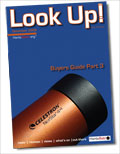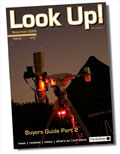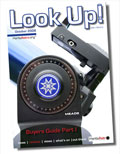Small Telescopes
Over the past few years, there has been a move away from the 'aperture fever' of big telescopes and a move towards smaller, more portable and easy to handle instruments. HantsAstro's current fleet of telescopes provides a broad range of beginner/intermediate telescopes of all major types bar Schmidt-Cassegrain, which is considered by many as a more advanced type.
For our purposes we concentrate on Refractor, Newtonian Reflector, Dobsonian and small Maksutov-Cassegrain telescopes, which are the four types that are commonly available.
Our Telescopes:
Vixen A70lf - 70mm Refractor
Skywatcher SkyMax 102 - Maksutov
Skywatcher Explorer 130/900 - Reflector
Skywatcher Explorer 150P - Reflector
Optrons 150/1400 - Reflector
Revelation 10 - Dobsonian
These telescopes were chosen for reasons of cost, portability and performance of a typical entry level telescope that can help anyone get off to a great start in astronomy. As you will discover, some 'scopes have advantages and disadvantages over others. In basic terms, it's how they deal with the light coming from a planet or star, deep sky object such as a Nebula, or for astrophotography.
Once you move to imaging, tracking your target makes the mount a very important factor, more so than for visual observations.
The focal length of a telescope plays a big part in defining its use. For instance, an f4 or f5 Newtonian Relflector is considered 'fast' (a bit like like the f-stop on a camera), whereas an f12-15 is considered excellent for planetary or stars. But aperture also comes into play.
Size does matter. Mostly.
As telescopes got better and cheaper during the 1990s, other types of telescope became more affordable. These were able to fold the light path into a stubby tube using mirrors, and apertures went up as the cost of mirrors and lenses went down. However, there is a saying that the best telescope is the one you use the most.
A 20" diameter Dobsonian not only requires a ladder to see though the eyepiece as it can stand 10 feet tall when pointed straight up(!), it is also very heavy and may require two or three people to set it up (by which time it usually clouds over!) As a result, it may only be used a few times a year.
A small telescope is ideal for starting and developing your skills. Relatively inexpensive, the types of 'scopes we have in our fleet allow our members to hone their skills on real-world equipment. Recently, smaller high-quality (read more expensive) refractors have become the vogue for visual observing and astrophotography but, due to costs, they are not ideal to start out with as some run into thousands of pounds! HantsAstro focused on telescopes in the £120-circa £1500 range.
Think Skywatcher 130 to 8" Meade LX90 and you'll get the idea. The criteria is usability and cost.
Check out our reviews for more info...
If you are starting out, a good pair of binoculars is a really good way to go. It's like a refractor for each eye, and a very quick way to find your way around armed with a star chart or while searching for an elusive target. Generally, a 130mm to 200mm (5"-8") diameter Newtonian ofrDobsonian is great, but if storage is at a premium then a small 'fast' refractor or binoculars are also a good solution.






